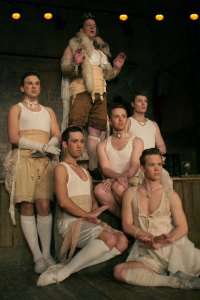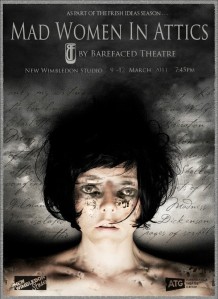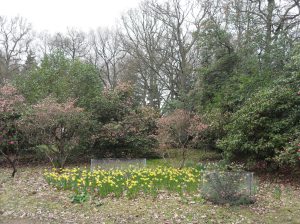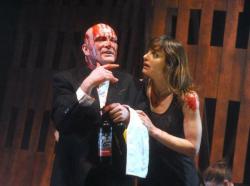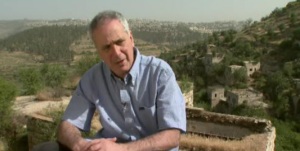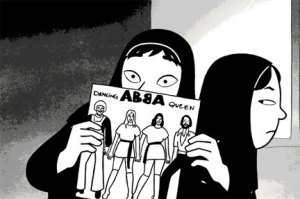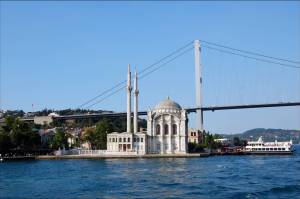Barnstaple to St Ives
150 miles, 30,000ft
April/May 2011
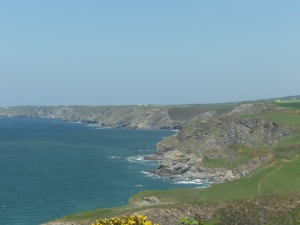
Day 1: Barnstaple to Appledore 13.6 miles, 531 ft
 Beautiful faultless weather, feels great to be outside all day. Flat easy path, an old railway path and now a cycle track. Nice but a little dull after a few miles. Bizarrely bumped into a guy from Amnesty who I used to work with at conferences, coincidences can be really strange. The path to Appledore was more interesting passing behind the Babcock Appledore site (which rung a bell as a place that I’ve had to check a payment to for work) and then had some lovely company through a nice little, slightly more residential stretch. Now I know I’m out of London as people aren’t afraid to talk to strangers.
Beautiful faultless weather, feels great to be outside all day. Flat easy path, an old railway path and now a cycle track. Nice but a little dull after a few miles. Bizarrely bumped into a guy from Amnesty who I used to work with at conferences, coincidences can be really strange. The path to Appledore was more interesting passing behind the Babcock Appledore site (which rung a bell as a place that I’ve had to check a payment to for work) and then had some lovely company through a nice little, slightly more residential stretch. Now I know I’m out of London as people aren’t afraid to talk to strangers.
Very good fish and chip supper in Appledore, accompanied by a Crabbie’s ginger beer from the pub opposite.
Day 2: Appledore to Clovelly: 14.2 miles, 2,589 ft
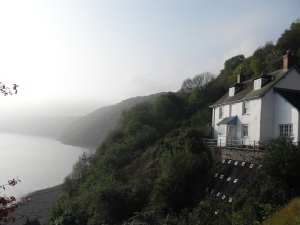 Slow, gloomy start – took it very easy going to Westward Ho to save strength for my first challenging day. Yup, a decent amount of climbing and a much more varied and interesting route than yesterday’s miles of cycle track. I made it to Clovelly in an ok time, but really did ache after. Something not quite right with how pack is sitting, hopefully will ease. But I had skittles to keep me going and met a lovely German couple who were also walking the path who kept me company on the last couple of miles, which could well have been a bit of a slog on my own. Had a lovely local beer at the harbour and then just about made it up the hill to my night’s stay, past the homemade sleds that are used for transporting stuff around the steep car-free streets.
Slow, gloomy start – took it very easy going to Westward Ho to save strength for my first challenging day. Yup, a decent amount of climbing and a much more varied and interesting route than yesterday’s miles of cycle track. I made it to Clovelly in an ok time, but really did ache after. Something not quite right with how pack is sitting, hopefully will ease. But I had skittles to keep me going and met a lovely German couple who were also walking the path who kept me company on the last couple of miles, which could well have been a bit of a slog on my own. Had a lovely local beer at the harbour and then just about made it up the hill to my night’s stay, past the homemade sleds that are used for transporting stuff around the steep car-free streets.
Day 3: Clovelly to Hartland Quay: 10.1 miles, 2,323 ft (well actually a bit further!)
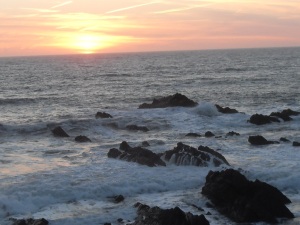 Following the man is a bad plan! As even though he said he was walking the coast path – after a little while of going inland and not climbing I realised that it couldn’t be the right way. Felt like ‘proper’ coastal path walking, two sections of steep ascents and descents separated by a gorgeous 4 mile cliff top stretch. Feeling sunkissed, but in pain and have developed my first proper blister. Tonight’s stay is amazing, right on a harbour, can hear the sea and spent Saturday night with the locals watching the popular entertainment – the sunset.
Following the man is a bad plan! As even though he said he was walking the coast path – after a little while of going inland and not climbing I realised that it couldn’t be the right way. Felt like ‘proper’ coastal path walking, two sections of steep ascents and descents separated by a gorgeous 4 mile cliff top stretch. Feeling sunkissed, but in pain and have developed my first proper blister. Tonight’s stay is amazing, right on a harbour, can hear the sea and spent Saturday night with the locals watching the popular entertainment – the sunset.
Day 4: Clovelly to Morwenstow: 8 miles, 2,000ft
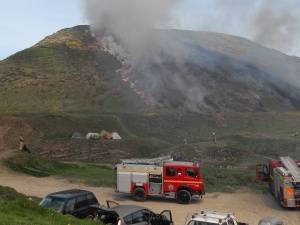 A scary day. Started with charging cattle, then proper cliff edges coming to a burning hillside. For a few miles along the cliff top we could all see smoke rising and then as I approached the descent the crackle and smell of burning gorse hit. Took a diversion and then saw the firefigters tackling the blaze. Could still the smoke at the end of the day. I’ve loved walking in this dry weather but the land is seriously parched.
A scary day. Started with charging cattle, then proper cliff edges coming to a burning hillside. For a few miles along the cliff top we could all see smoke rising and then as I approached the descent the crackle and smell of burning gorse hit. Took a diversion and then saw the firefigters tackling the blaze. Could still the smoke at the end of the day. I’ve loved walking in this dry weather but the land is seriously parched.
Day 5: Morwenstow to Bude: 7 miles, 2,000ft
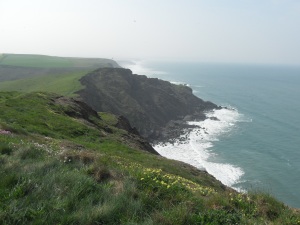 Very glad that I split the suggested itinerary (Hartland Quay to Bude) in two – really would have struggled to do that in one day, especially with the arrival of a huge blister under my big toe. Had a lovely evening as I bumped into a couple who I had been following since around Hartland Point, really nice to share some wine and company, made more welcome as I was in an odd mood for some of the day, beginning to sort through some stuff in my head.
Very glad that I split the suggested itinerary (Hartland Quay to Bude) in two – really would have struggled to do that in one day, especially with the arrival of a huge blister under my big toe. Had a lovely evening as I bumped into a couple who I had been following since around Hartland Point, really nice to share some wine and company, made more welcome as I was in an odd mood for some of the day, beginning to sort through some stuff in my head.
Day 6: Bude to Crackington Haven: 10.2 miles. 2,664ft
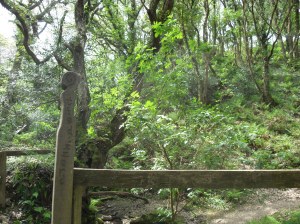 Received a phone call from a journalist about the fire and made the local newspaper http://www.thisisnorthdevon.co.uk/news/Battling-blaze-Welcombe-cliffs/article-3490793-detail/article.html after I sent them a picture from the B&B that night. And then had the extreme joy of bursting my blister after a couple of hours walking before the cliff walking got strenous. A lovely stay tonight, offered saffron bread in the garden and interesting chats with the other guests. Definitely the best bed of the stay and an award for the best sausage as well goes to Hallagather.
Received a phone call from a journalist about the fire and made the local newspaper http://www.thisisnorthdevon.co.uk/news/Battling-blaze-Welcombe-cliffs/article-3490793-detail/article.html after I sent them a picture from the B&B that night. And then had the extreme joy of bursting my blister after a couple of hours walking before the cliff walking got strenous. A lovely stay tonight, offered saffron bread in the garden and interesting chats with the other guests. Definitely the best bed of the stay and an award for the best sausage as well goes to Hallagather.
Day 7: Crackington Haven to Tintagel: 12 miles, 4,045 ft
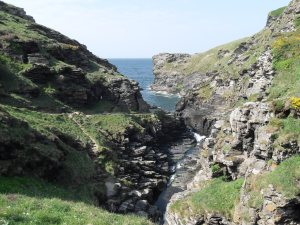
My greatest climb in one day and was properly shattered by the end. Today’s walk passed through the very picturesque Boscastle Harbour, now recovered from the sever flooding of 2004. Another very welcome slice of homemadecake (banana this time) on arriving at the B&B, really enjoying this Cornish hospitality.
Day 8: Tintagel to Port Isaac: 9 miles, 2,740 ft
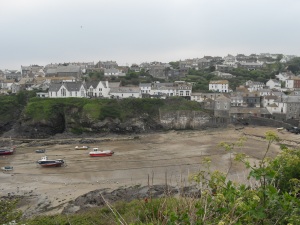 Today’s walk had 9 deep valleys to cross and sometimes very close edges along the top so a day filled with adrenalin and endorphins. I was very pleased with my time for the walk today and got rewarded by a fabulous pint, good company and a foot massage in Port Gaverne. These were definitely my toughest 2 days and I really should have included a rest day at some point but the goal of reaching St Ives seemed all important.
Today’s walk had 9 deep valleys to cross and sometimes very close edges along the top so a day filled with adrenalin and endorphins. I was very pleased with my time for the walk today and got rewarded by a fabulous pint, good company and a foot massage in Port Gaverne. These were definitely my toughest 2 days and I really should have included a rest day at some point but the goal of reaching St Ives seemed all important.
Day 9: Port Isaac to Padstow: 11.7 miles, 2,802 ft
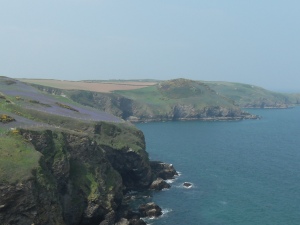 Strangely this became the toughest day to get through, despite being comparitively easy after the last two days. The steep cliffs, strenous climbs and precipitous paths gave way to rolling heathland and secluded sandy coves. Youth hostel stay at Treyannon Bay was gorgeous with another truly engaging sunset. Pushing myself to the limit has forced me to stop and take tomorrow as a short day and not going back to Padstow to continue from there. I found Padstow on a bank holiday to be claustrophobic with far too many people, wanted to leave as quickly as possible!
Strangely this became the toughest day to get through, despite being comparitively easy after the last two days. The steep cliffs, strenous climbs and precipitous paths gave way to rolling heathland and secluded sandy coves. Youth hostel stay at Treyannon Bay was gorgeous with another truly engaging sunset. Pushing myself to the limit has forced me to stop and take tomorrow as a short day and not going back to Padstow to continue from there. I found Padstow on a bank holiday to be claustrophobic with far too many people, wanted to leave as quickly as possible!
Day 10: Treyannon Bay to Porthcothan Bay, 2 miles
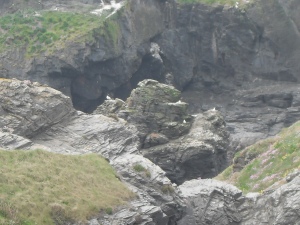 And the day I decided to have a rest day and sit on the beach is the first day of rain! So I found my B&B and spent the afternoon watching the snooker – a riveting semi final. Just a side note on food, in general not as good as I had anticipated so has become more of a necessity instead which is a shame as I had higher hopes.
And the day I decided to have a rest day and sit on the beach is the first day of rain! So I found my B&B and spent the afternoon watching the snooker – a riveting semi final. Just a side note on food, in general not as good as I had anticipated so has become more of a necessity instead which is a shame as I had higher hopes.
Day 11: Porthcothan Bay to Newquay: 11.1 miles, 1,755ft
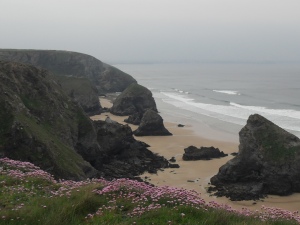 Proper soaking today, so yes it was worth carrying those waterproofs all this way. I’m very glad to be able to sense the ending as the fatigue is getting to me. The choice of where to eat in Newquay was slightly overwhelming so I was delighted when my hosts tonight offered my dinner and along with a couple of other guests it was a wonderful evening. If you want somewhere to stay in Newquay with down to earth lovely people the Chichester comes highly recommended.
Proper soaking today, so yes it was worth carrying those waterproofs all this way. I’m very glad to be able to sense the ending as the fatigue is getting to me. The choice of where to eat in Newquay was slightly overwhelming so I was delighted when my hosts tonight offered my dinner and along with a couple of other guests it was a wonderful evening. If you want somewhere to stay in Newquay with down to earth lovely people the Chichester comes highly recommended.
Day 12: Newquay to Perranporth: 10.8 miles, 1,586ft
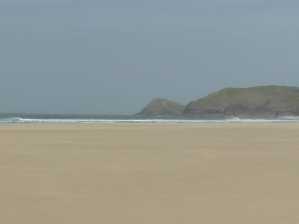 No rain today but quite severe winds made it a bit scary along the cliff tops and fierce along the beach. It took quite a long time to get the sand out of my eyes and ears. Feeling close to the end of my endurance. No aching muscles but feet and ankles sore and energy levels quite low. Tomorrow should be the last day of any significant difficulty so hoping for less wind and less dunes and beach walking.
No rain today but quite severe winds made it a bit scary along the cliff tops and fierce along the beach. It took quite a long time to get the sand out of my eyes and ears. Feeling close to the end of my endurance. No aching muscles but feet and ankles sore and energy levels quite low. Tomorrow should be the last day of any significant difficulty so hoping for less wind and less dunes and beach walking.
Day 13: Perranporth to Portreath: 12.2 miles, 2,454ft
 Far too windy today and after not enjoying yesterday on the cliffs I decided to walk the roads to Porthtowan and then last few miles back on the coast, when the wind had died down a little and the path was not so high. Very glad to have had one of my best meals in the pub in Portreath, a lovely home made spinach, mushroom and hazelnut pie and a night in a wonderfully presented B&B.
Far too windy today and after not enjoying yesterday on the cliffs I decided to walk the roads to Porthtowan and then last few miles back on the coast, when the wind had died down a little and the path was not so high. Very glad to have had one of my best meals in the pub in Portreath, a lovely home made spinach, mushroom and hazelnut pie and a night in a wonderfully presented B&B.
Day 14: Portreath to Hayle: 12.4 miles, 1,371ft
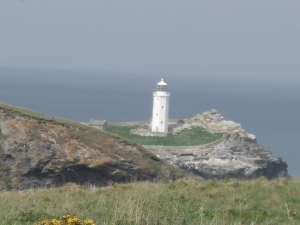 Still a bit windy but nothing like the last 2 days. This is a really lovely stretch with the lighthouse at Godrevy, seals in the bay, high but not vertiginous cliffs and a long stretch along the beach. The signing and directions were a little bit lacking around Hayle so got lost a couple of times which at this level of fatigue was a little frustrating.
Still a bit windy but nothing like the last 2 days. This is a really lovely stretch with the lighthouse at Godrevy, seals in the bay, high but not vertiginous cliffs and a long stretch along the beach. The signing and directions were a little bit lacking around Hayle so got lost a couple of times which at this level of fatigue was a little frustrating.
Day15Hayle to St Ives: 5.6 miles, 663ft
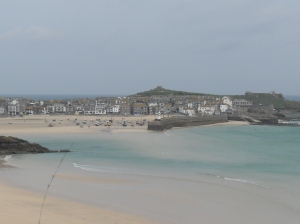 The first half was dreadful, along the roads with differing directions in the two books and with poor signing leading me on a diversion. Once back on the coast the last three miles were a perfect end with nothing too strenous with St. Ives in sight, a little bit of sunshine and right on the cliffs but not too high. The last mile felt like a real achievement and I had feelings of elation at reaching the end of this stretch, looking back over the past two weeks with joy and also a real excitement about returning to friends and home.
The first half was dreadful, along the roads with differing directions in the two books and with poor signing leading me on a diversion. Once back on the coast the last three miles were a perfect end with nothing too strenous with St. Ives in sight, a little bit of sunshine and right on the cliffs but not too high. The last mile felt like a real achievement and I had feelings of elation at reaching the end of this stretch, looking back over the past two weeks with joy and also a real excitement about returning to friends and home.
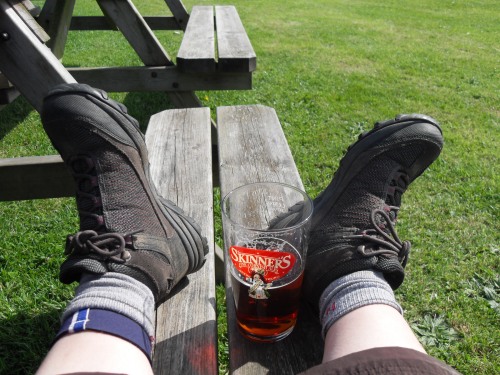
 Language surrounds us, defines who, what and where we are.
Language surrounds us, defines who, what and where we are.
















